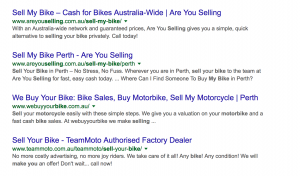SEO Sydney has found search is changing and evolving more rapidly than ever and the use of Schema Markups and rich snippets are becoming a significant feature of search engine results and as a result many website owners are wondering how to write easy structured data for their website. Rich snippets are enhancing the SERPs, by giving users more information before they click. They are useful in drawing a user’s attention to your result but are far from easy for your average webmaster to implement. Rich snippets provide instant information relating to a user’s search query and thus increases the click-through rate and traffic to the website, while reducing bounce rate. In 2011, Google, Microsoft and Yahoo announced a collaboration in supporting a set of microdata types that allow the use of structured data markups and numerous companies, including Independer (a Dutch car insurance company) and Catalyst Search Marketing, have reported that they saw a 20-30% increase in their click-through rate, when utilising rich snippets. But the use of these structured data markups require proficient developer resources and coding that may not be accessible to everyone, especially those who are looking for techniques to easily display structured data.
The Data Highlighter is a tool developed by Google, and accessed via Google Webmaster Tools, that allows you to markup your page and easily display structured data, acting as an alternative to rich snippet coding while still maintaining the rich and versatile information that captures the user’s attention. This allows Google to improve its search result snippets to its users, listing event information (location and time), reviews (star ratings and customer ratings) and product information (price and specifications), without the use of code. The Data Highlighter allows you to provide this information based on a point-and-click tool that tags your site to its specifications. The tool essentially teaches Google about your site’s pattern of structured data, tagging data such as event name, location and time, that can then be presented as a rich snippet for the search query.
The supported data types that Data Highlighter can markup include:
- Articles
- Events
- Local Businesses
- Products
- Restaurants
- Software Applications
- Books
- TV Episodes
- Movies
The data tags that Data Highlighter can assign to the markups include:
- Name
- Date
- Location
- Image
- Official URL
- Category
- Performer
- Ticket
The process works by highlighting segments of your site and assigning it to the data type, then applying data tags to the markup to display the necessary information.
To implement the Data Highlighter tool, follow these steps:
- Log into Google Webmaster Tools.
- Click Data Highlighter under Search Appearance.
- Click on Start Highlighting.
- Input the URL of a page on your website and the type of information to highlight.
- Using the mouse, highlight the fields you want and select the tag attributed to the data.
- When you’re done, click Publish.
If your page lists the data in a consistent format, as you tag the content of your site, the tool will ‘learn’ the layout to apply to the tags after 5 to 10 manually tagged pages. However, this process isn’t perfect and if an item isn’t located in a consistent manner to the other pages, the tool may have a problem finding the items to compose the markup. By creating page sets, you can create a collection of pages on the site that will display data consistently, informing Data Highlighter which pages contain consistent data to be displayed via Google. However, if any significant changes are made to the manner in which the site displays information, the page set will need to be rebuilt to teach Data Highlighter the new structure of the site.
Benefits of Data Highlighter
By utilising Data Highlighter, you can improve your site’s listing on the search engine results page (SERP). Snippets are helpful in attaining the user’s attention and increase click-through rate and traffic. The tool is intuitive and user-friendly without the need for code, providing an ease of use for many users.
Limitations of Data Highlighter
While the Data Highlighter is a quick and easy method for producing rich snippets, the practical manner of the tool allows for some issues and is not always a perfect alternative. If you change any portion of the page’s coding, you will need to rebuild the snippet entirely. Additionally, the data is only visible to the Google search engine, so other search engines that crawl your site, such as Bing and Yahoo, will not be able to display the markup.
Just as Google Data Highlighter was a progression from structured data markups, so too can we expect the future of SEO to further develop the ease of providing versatile information to the search engines. As a way to provide a better user experience, Google, Bing and Yahoo have identified the relationship between structured vs. unstructured content in providing higher quality results for users, allowing for greater engagement. Data Highlighter was a significant step by Google to make the process of presenting data and information as simple and easy as possible for all website owners. To ensure that the search engines continue to display the best results, Google’s efforts in eliminating the technical constraints that often acted as an obstacle to high quality content, has largely been a successful feat. The introduction of Google Data Highlighter has emphasised the intention of web users and how they interact with structured data. It opens the door for continued innovation in SEO tools that allow for those website owners who don’t have the technical skills to maintain the coding of the website or the resources for developers. However, it has the potential to bring with it the risk of webmasters disregarding the importance of coding and might generate a trend that sees them avoiding developing code for certain aspects. While we can’t overlook the fact that HTML code is a vital foundation to these websites, with the ease of the point and click nature of the tool, it allows for a wide market adoption from both small to large businesses, which both might have different challenges with employing the more technical varieties.
This is just the first step in making it easier for webmasters to produce the most relevant content for its users. The development of the Data Highlighter tool leads to the opportunity to expand it to other instances of structured data outside of the currently supported data types. Google have recently released rich cards, the next evolution of rich snippets to improve the mobile user’s search experience and present a new way in which to display structured data in a carousel at the top of the search results. Web searchers are increasingly using their mobiles to search on the go and by utilising the Google Data Highlighter tool to enhance rich cards, webmasters are able to take advantage of the evolution and growth of mobile searches. As users use their mobile devices more and more to perform web searches, continuing to target these searches with Google Data Highlighter will be an important focal point as we progress to the future. If you would like some assistance with using Google Data Highlighter, check out SEO Sydney – the experts in providing professional and proven SEO services and resources today!



